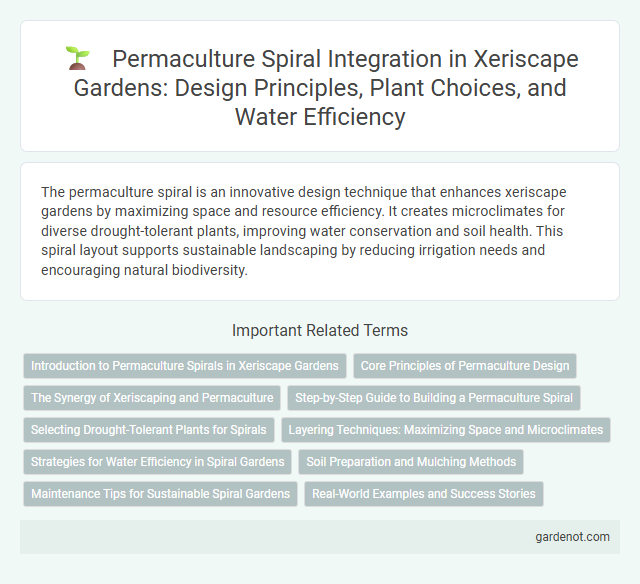The permaculture spiral is an innovative design technique that enhances xeriscape gardens by maximizing space and resource efficiency. It creates microclimates for diverse drought-tolerant plants, improving water conservation and soil health. This spiral layout supports sustainable landscaping by reducing irrigation needs and encouraging natural biodiversity.
Introduction to Permaculture Spirals in Xeriscape Gardens
Permaculture spirals in xeriscape gardens integrate water-efficient plant arrangements that maximize microclimates and soil nutrient cycling. These spirals create diverse habitats by layering succulents, herbs, and drought-tolerant plants in a compact, spiral form, enhancing moisture retention and reducing irrigation needs. Strategic placement within xeriscape designs boosts biodiversity while conserving water resources in arid landscapes.
Core Principles of Permaculture Design
The Permaculture spiral embodies core principles such as efficient water usage, diverse plant integration, and soil regeneration, crucial for xeriscape design. Its layout maximizes microclimates, enabling the cultivation of drought-tolerant species while minimizing irrigation needs. This sustainable approach enhances ecosystem resilience and conserves water in arid environments.
The Synergy of Xeriscaping and Permaculture
Permaculture spirals enhance xeriscaping by maximizing water efficiency and promoting biodiversity within a compact space, utilizing diverse plant species arranged according to their water and sunlight needs. This synergy creates self-sustaining ecosystems that reduce irrigation demands while improving soil health through natural mulching and organic matter retention. Integrating xeriscape principles with permaculture spirals supports resilient landscapes adaptable to drought and climate variability.
Step-by-Step Guide to Building a Permaculture Spiral
Constructing a permaculture spiral begins with selecting a sunny, well-drained site and marking a spiral shape on the ground, typically about 1.2 meters in diameter. Build the spiral by layering rocks, bricks, or soil to create terraces that increase surface area and microclimates for diverse plant growth. Incorporate water-retentive materials and plant drought-tolerant herbs like thyme, rosemary, and oregano at the top while moisture-loving plants such as mint and chives occupy the lower spiral zones for optimized xeriscaping.
Selecting Drought-Tolerant Plants for Spirals
Selecting drought-tolerant plants for a permaculture spiral involves choosing species that thrive in low-water conditions and promote soil health. Key plants include succulents like agave, drought-resistant herbs such as rosemary and thyme, and native grasses that prevent erosion and conserve moisture. This approach maximizes water efficiency and supports biodiversity within xeriscape gardens.
Layering Techniques: Maximizing Space and Microclimates
Permaculture spirals in xeriscape design utilize advanced layering techniques to maximize space efficiency and create diverse microclimates that support drought-tolerant plant species. By arranging plants vertically and in close proximity, the spiral conserves water through reduced evaporation and allows for varied sun and shade exposure, optimizing growth conditions. This method enhances soil moisture retention and biodiversity, essential for sustainable xeriscape ecosystems.
Strategies for Water Efficiency in Spiral Gardens
Permaculture spiral gardens utilize contouring and keyhole design to maximize water retention and minimize evaporation, enhancing overall water efficiency. Implementing mulch layers and drought-tolerant plant species within the spiral structure significantly reduces irrigation requirements. Strategic placement of swales and catchment basins in the spiral further captures and redistributes rainwater, promoting sustainable xeriscape practices.
Soil Preparation and Mulching Methods
Permaculture spirals optimize water retention and nutrient cycling by incorporating layers of organic matter and soil amendments in a compact design, enhancing xeriscape soil health. Soil preparation involves loosening soil structure and adding compost or biochar to improve moisture absorption and microbial activity. Mulching methods focus on applying thick, organic mulches such as straw, wood chips, or leaf litter to suppress weeds, reduce evaporation, and maintain consistent soil temperature in arid environments.
Maintenance Tips for Sustainable Spiral Gardens
Permaculture spiral gardens reduce water use and support biodiversity through layered planting and natural microclimates, making maintenance efficient and eco-friendly. Consistent mulching conserves soil moisture while minimizing weeds, and pruning encourages healthy growth without excessive resource use. Regularly monitoring soil health and integrating companion planting enhances pest resistance and sustains the garden's productivity with minimal inputs.
Real-World Examples and Success Stories
The permaculture spiral is a versatile xeriscape design that maximizes water efficiency and plant diversity in arid environments. In Arizona, a community garden used the spiral to create microclimates, allowing drought-tolerant herbs and succulents to thrive while conserving up to 50% of irrigation water. Similar success in California's Central Valley demonstrated increased crop yields and reduced water usage, validating the spiral's sustainable impact in real-world xeriscaping.
Permaculture spiral Infographic

 gardenot.com
gardenot.com